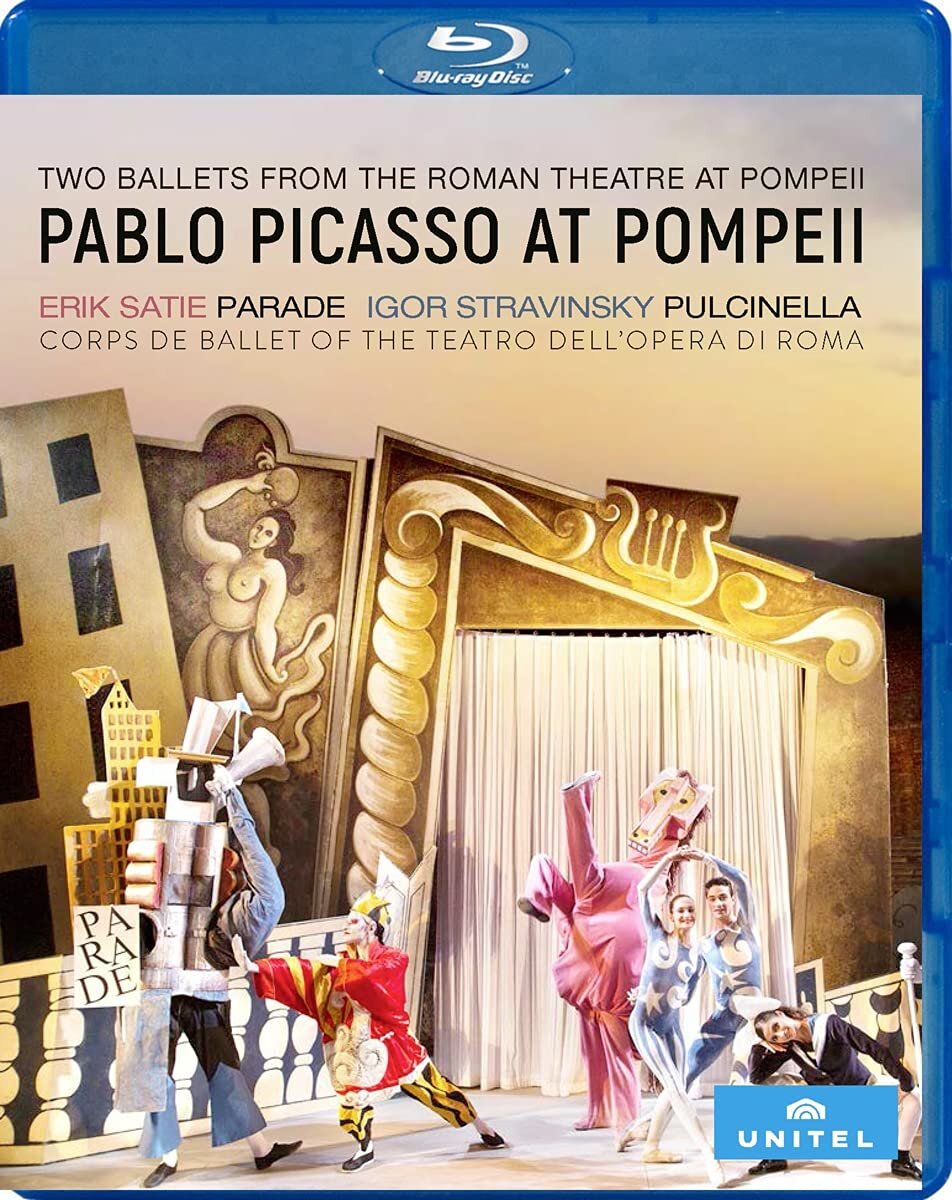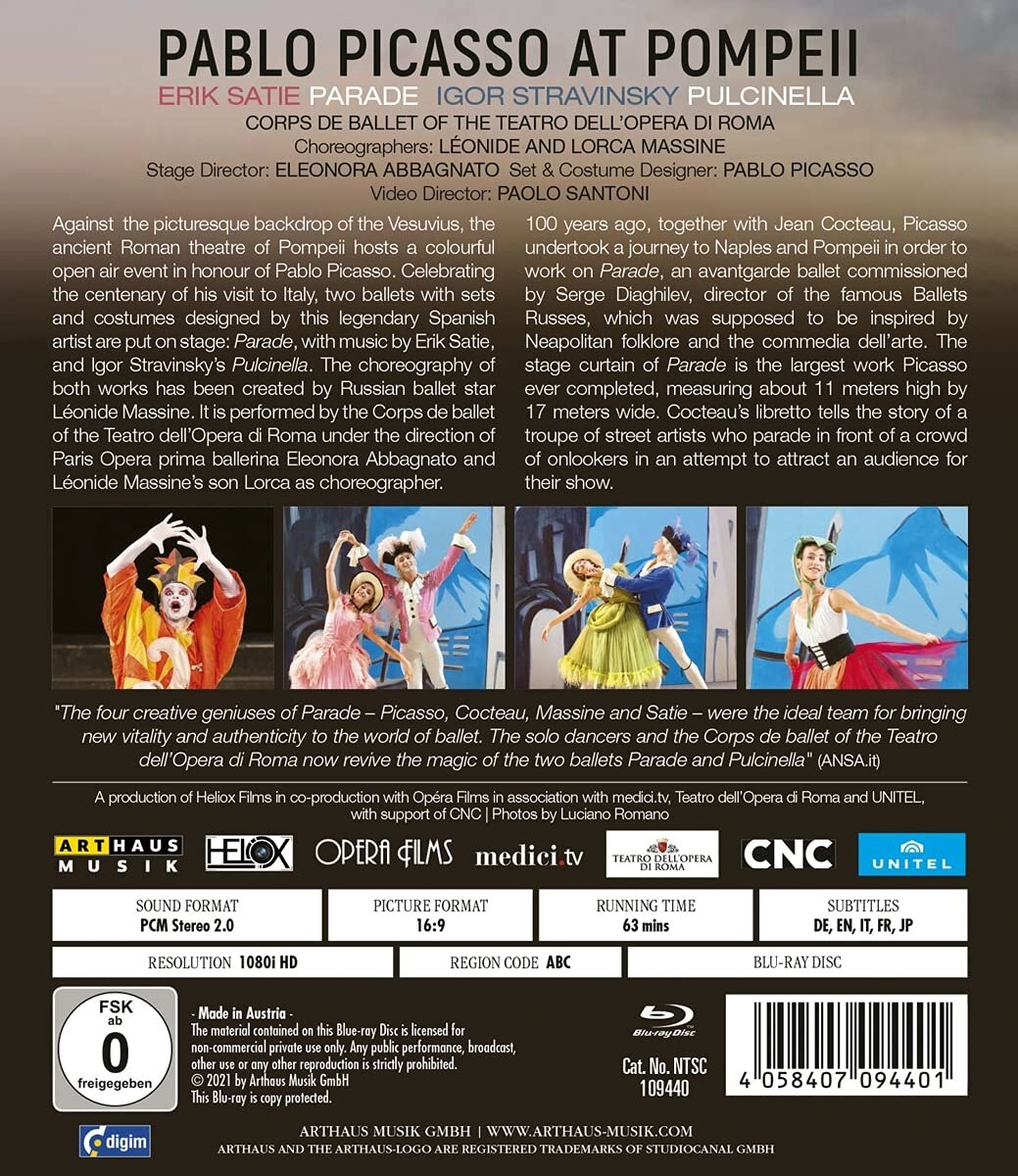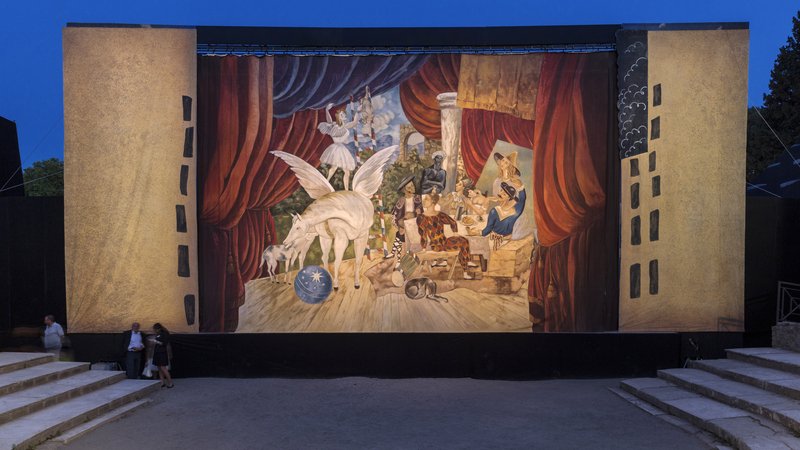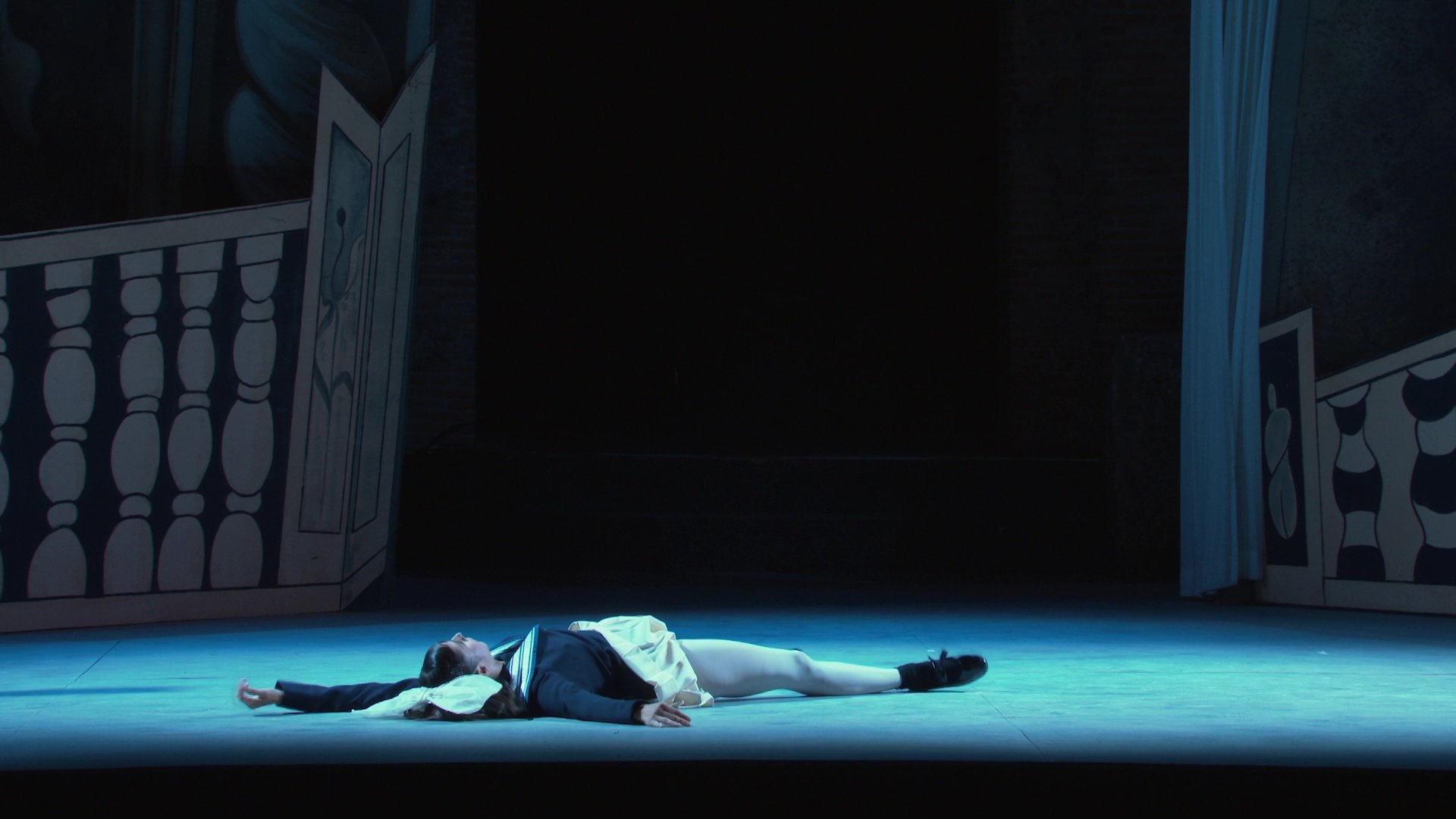

Pablo Picasso at Pompeii. Features two ballets: Parade, with pre-recorded music by Satie, runs about 24 minutes; Pulcinella, with pre-recorded music by Stravinsky, runs about 36 minutes. Directed 2017 by Eleonara Abbagnato at the ancient outdoor Roman Theater at Pompeii. Choreography by Léonide Massine (father) revived by Lorca Massine (son). Stars the Corps de Ballet of the Teatro dell’Opera di Roma. Set designs by Pablo Picasso reconstructed by Maurizio Varamo. Costumes by Picasso reconstructed by Anna Biagiotti. Lighting by Mario De Amicis. Directed for TV by Paolo Santioni. No keepcase booklet. Stravinsky’s score for Pulcinella includes parts for soprano, tenor, and bass. Subtitles selected by remote control (not a menu). Released 2021, disc has PCM stereo sound. Grade: A
This show harks back to World War I when Picasso and Jean Cocteau visited Italy to work on the Parade ballet for impresario Diaghilev of the famed Ballet Russes. Parade premiered in Paris in 1917. Far ahead of its time, the original created scandal. Undaunted, Diaghilev premiered Pulcinella in Rome in 1920 with similar forces.
I get the impression that neither Parade nor Pulcinella has been regularly performed. But in 2017, the Italian Ministry of Culture decided to support a revival of both works to celebrate the centenary of Picasso’s visits to Italy. A result was this double feature performed outside at the ruins of the Roman Theater at Pompeii. The sound is in stereo only. We usually exclude titles performed in vast public spaces and also recordings in stereo. But we make exceptions for dance titles in stereo (usually with recorded rather than live music). Here we make a double exception (outdoor venue and sound) as this title is surrealistically irresistible.
Special Curtain
The largest artwork ever created by Picasso was the stage curtain for Parade. You see the the original in the image below:
The ancient theater at Pompeii:
A temporary stage was built. Our next image shows the new curtain at dusk (weak outdoor light):
Here are better views of the curtain. Those in the knows can identify each of the individuals in the picture:
Below left is an undated announcement for Parade. The announcement below right is dated for the premiere of Parade, but no piece is named! These were difficult times for Diaghilev and his company:
Here is a photo of Picasso on the left and choreographer Léonide Massine on the right while visiting Italy:
Parade
Ballet began in France in the Royal Courts and later flourished in Imperial Russian under the Tsars. The glories of Russian Ballet were reintroduced in western Europe between 1909 and 1929 by impresario Sergei Diaghilev and his Ballets Russes. But by 1917, World War I had disrupted the fortunes of grand ballet. Diaghilev and his new choreographer Massine had to improvise by working with artists from France and Spain like Cocteau, Satie, Stravinsky, and Picasso.
Parade was the first new work to emerge from the new talents. According to Jennifer Homans in her Apollo’s Angels history of ballet, Parade “represented a choreographic low for the Ballet Russes.” The new artists, especially Picasso, were overshadowing the choreography. The “lightweight chic” of Parade “seemed in poor taste” to the audience in Paris burdened by concerns of the great war. A riot almost broke out in the theater. The poet Guillaume Apollinaire was in the audience and coined the word “surrealism” to describe Parade! Later there were arguments, fisticuffs, and trials. Satie somehow wound up spending 8 days in jail!
What a difference 100+ years can make. Even though Satie’s music today sounds a bit dry and angular, Parade can’t be seen as anything but charming. Set in Paris, the dance opens with two poor managers loosing money backing a circus in town. In desperation, they have hired stars from the circus to sell tickets performing in the streets. Next below is Loic Pireaux as the American Manager:
And here is Giacomo Castellana as the French Manager:
Manuel Paruccini is dynamic as The Chinese Magician:
Christina Mirighliano is the America Girl. In a riot of hyperactivity, she burns a pound a minute:
The horse is unbelievably winsome. This is a significant stunt for strong dancers Luca D’Ottavio and Lugi Corrade:
The beautiful acrobats are Sara Loro and Michele Satriano:
And here is the finale and a better look at Picasso’s set:
Pulcinella
Pulcinella is far more elaborate than Parade. Next below are the credits at the end of the show.
We are in a neighborhood square in Naples with mansions on the left and right. Pulcinella is that stock character from the Italian commedia dell’arte who dresses in white and has a big nose covered with a black mask. He can play many roles, but he’s usually a kind of rascal who through ingenuity or blind luck always comes out on top (or at least alive). Pulcinella is played by Claudio Cocino. He loves to philander with girls even though he has a steady girl (or maybe a common-law wife) named Pimpinella (Rebecca Bianchi). In this show there are 4 extra Pulcinellas (Giacomo Castellana, Luigi Corrado, Giovanni Castelli, and Massimiliano Rizzo) + a big chorus of juvenile P’s.
In each mansion there dwells a beautiful girl of marriageable age. They are Prudenza (Marianna Suriano) and Rosetta (Elena Bidini). Each girl is constantly spied on by a father guarding her virginity. Caviello (Giaseppe Depalo) and Florindo (Giacomo Luci) are two young noblemen hanging around trying to seduce the girls. Pulcinella looks on for ways to take advantage:
The girls are not very impressed. Each empties a chamber pot on the swains below. In Mexico the expression “¡Echeme agua!” mean “Watch out!” It really means, “Contents of a chamber pot headed your way!”
But eventually the girls venture out on the street to the displeasure of their fathers:
The girls are more interested in Pulcinella than the boys. But watch out! Pimpinella has arrived:
Pulcinella is put out:
And Pimpinella is back in control:
The young men try to punish Pulcinella, and things get out of control:
Pulcinella dies and the street people go into mourning:
But a Magician just happens to come along:
And raises Pulcinella from the dead:
The Magician also marries the young couples:
And everybody is in his proper place! But ask yourself these questions: (1) Exactly who was dead on the street? and (2) Exactly who was this Magician? If you can figure it out, let me know:
Picasso isn’t talking, but he does suggest that Vesuvius is about the cover up Pompeii again:
Stravinsky’s music for Pulcinella is great. All of this is so much fun to watch that we will not worry about PQ, SQ, DVDitis, or anything else. It’s the perfect disc to show your friends and neighbors before you have them audition your new recording of Parsifal. Your chances of seeing Parade or Pulcinella live are about the same as whether you will ever be a space tourist. Grade A.
Here’s an official trailer:
OR














































